Essential Software for Consultants: Elevate Your Workflow with These Tools

You’ve probably heard the saying, “Penny wise, dollar foolish.” That was me in the first year of my business. Cash was tight, so I avoided spending money on anything I could do manually. Payroll? I ran the numbers and wrote checks by hand just to save $50.
A CRM? I put it off for months, then finally got one license, but instead of paying $65/month for a second, my colleague and I shared the same login with a messy, inefficient naming system to track leads separately.
Looking back, I was wasting my time just to save a few bucks on technology. I understand that when cash is low, you do what you have to. But once you have revenue and profit, don’t go cheap on tech. The right tools, when properly adopted and used, can be a valuable asset for your business.
I want to walk you through the essential software for consultants that I’ve used across my ventures. I’ll break down their pricing, key features, and what to look for when choosing the right tool for your business. Whether you’re just starting out or looking to scale, investing in the right technology will help you work smarter, faster, and more efficiently.
Pricing and Features
The pricing and features listed in this guide are examples based on current offerings from each software provider. However, prices and features can change at any time as companies update their plans. Before making a decision, always check the official website of the tool for the latest pricing, features, and terms.
Project and Task Management Software for Consultants
Effective project and task management is critical if you are juggling multiple deadlines and client needs. Tools like Asana and Trello stand out as excellent choices, but which one is right for you?
Asana
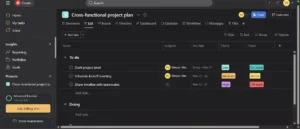
Pricing
- Starter Plan: $10.99/user/month billed annually ($13.49 billed monthly).
- Advanced Plan: $24.99/user/month billed annually ($30.49 billed monthly).
- Enterprise Plan: Contact sales for pricing.
Key Features
- Multiple project views
Asana offers list, board, calendar, timeline, and Gantt views, making it adaptable to different work styles. Use lists for detailed tasks, boards for visual tracking, and timelines for mapping dependencies. This flexibility helps consultants manage simple to complex workflows effectively. - Automated workflows
With the Workflow Builder, Asana automates repetitive tasks, saving time and reducing errors. The Starter plan offers 250 automations/month, while the Advanced plan provides up to 25,000, making it ideal for consultants managing dynamic workflows. - AI capabilities
Asana’s AI tools, such as smart goals and workflow optimization, simplify decision-making. These features align tasks with goals, provide automated updates, and suggest improvements to maximize productivity. - Advanced reporting tools
Custom dashboards offer actionable insights into project performance. You can track KPIs, spot bottlenecks, and make data-driven decisions, making this feature a must for scaling businesses. - Resource management
Asana includes time tracking and workload planning, ensuring resources are allocated efficiently. These tools prevent burnout while keeping team productivity high.
Pluses
- Scalability: Suitable for growing teams with advanced tools for consultants to manage complex projects.
- Efficiency: Automations and AI save time and reduce manual work.
- Detailed reporting: Custom dashboards provide insights to monitor progress and optimize workflows.
- Flexible views: Multiple project views accommodate diverse work styles.
Barriers
- Cost: Plans start at $10.99/user/month, which can strain small budgets.
- Learning curve: Extensive features can feel overwhelming for beginners.
- Internet reliance: Requires stable connectivity for consistent use.
Trello
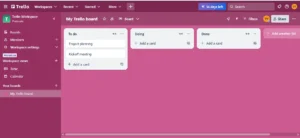
Pricing
- Free Plan: $0 for up to 10 boards per Workspace.
- Standard Plan: $5/user/month billed annually ($6 billed monthly).
- Premium Plan: $10/user/month billed annually ($12.50 billed monthly).
- Enterprise Plan: $17.50/user/month billed annually.
Key Features
- Kanban boards
Trello’s drag-and-drop boards make it easy to track tasks through stages like “To-Do,” “In Progress,” and “Done.” It’s perfect for consultants managing straightforward workflows. - Power-ups (Custom Add-Ons)
Power-Ups enhance functionality with tools like Calendar and Timeline views. While free plans include unlimited Power-Ups per board, advanced features are locked behind Premium subscriptions. - Unlimited storage
Free plans allow file uploads up to 10MB, while paid plans increase the limit to 250MB, making Trello suitable for teams sharing resources like documents or presentations. - AI assistance
Basic AI tools help prioritize tasks and simplify project planning. Though less flexible than Asana’s AI, it adds value for startups. - Workspace views
Premium plans offer Calendar and Table views, providing consultants with alternative ways to visualize projects and deadlines.
Pros
- Ease of use: Beginner-friendly interface with minimal setup required.
- Affordability: Free and Standard plans are budget-friendly, starting at $5/user/month.
- Customization: Power-Ups allow flexibility to adapt boards to specific needs.
- Collaboration: Real-time updates ensure alignment across teams.
Cons
- Limited reporting: Lacks advanced analytics and dashboards for tracking progress.
- Scaling issues: Simplicity may hinder large or complex projects.
- Restricted automation: Standard plans cap automation commands at 1,000/month.
Asana vs. Trello Comparison
| Feature | Asana | Trello |
| Best For | Growing teams managing complex projects | Startups and small teams on budget |
| Pricing | Starts at $10.99/user/month | Starts at $5/user/month |
| Ease of Use | Moderate learning curve | Extremely user-friendly |
| Views | List, board, calendar, timeline, and Gnatt views | Kanban, calendar, and table views |
| Automations | 250-25,00/month (depending on plan) | Limited in standard and below |
| AI Features | Smart goals, status updates, and workflow builder | Basic task suggestions |
| Reporting | Advanced dashboards, charts and custom reports | Minimal reporting in premium |
Which One is Right for You?
- Choose Asana if you need scalability, advanced reporting, and automation for complex project management. It’s best for teams looking to grow, though it comes at a higher cost.
- Choose Trello if you prioritize simplicity, affordability, and visual task management. It’s perfect for startups but may lack features as your needs expand.
Best Communication Software for Consultants
Great communication can make or break a consulting business. Whether it’s coordinating with your team or impressing clients, the right tools can transform how you work.
Slack
Pricing
- Free Plan: $0, includes limited message history (90 days) and 10 app integrations.
- Pro Plan: $7.25/user/month billed annually ($8.75 billed monthly).
- Business+ Plan: $12.50/user/month billed annually ($15 billed monthly).
- Enterprise Grid: Contact sales for pricing.
Key Features
- Real-time communication
Slack is built for messaging with channels for team discussions and private chats for one-on-one conversations. It supports file sharing, threaded conversations, and customizable notifications to keep communication efficient and focused. - Unlimited integrations
With over 2,000 app integrations, Slack connects effortlessly with tools like Google Drive, Zoom, and Trello. This ensures all your favorite apps work together in one place, streamlining your workflow. - Slack huddles
Voice-first huddles enable quick, informal check-ins with up to 50 participants. They are ideal for impromptu collaboration without the formality of scheduled calls, making team communication feel more organic. - Slack AI (Add-on)
Available for $10/user/month, Slack AI provides smart summaries of discussions, thread recaps, and task suggestions, enhancing decision-making and productivity. - Security and compliance
Higher-tier plans offer enterprise-grade security features like SAML-based SSO, data encryption, and HIPAA compliance. These are critical for ensuring safe and compliant communication, especially for service-based businesses handling sensitive client information.
Pros
- Flexible communication: Channels, private chats, and huddles make team collaboration easy and organized.
- Integrations: Over 2,000 app connections help centralize your tools and improve efficiency.
- User-friendly: The intuitive interface reduces the learning curve, even for new users.
- Scalable security: Advanced security features on Business+ and Enterprise plans provide peace of mind for scaling teams.
Cons
- Cost: Plans start at $7.25/user/month, and adding AI increases the price, which may be a challenge for small startups.
- Limited video capabilities: While Slack excels in messaging, its video conferencing features are not as flexible as competitors like Microsoft Teams.
- Storage limits on free plan: Only 90 days of message history and limited app integrations may hinder growing teams.
Microsoft Teams
Pricing
- Teams Essentials: $4/user/month (annual subscription).
- Microsoft 365 Business Basic: $6/user/month (annual subscription).
- Microsoft 365 Business Standard: $12.50/user/month (annual subscription).
- Microsoft 365 Business Premium: $22/user/month (annual subscription).
Key Features
- Integrated collaboration
Microsoft Teams combines messaging, file sharing, and video conferencing in one platform. With Teams Essentials, users get unlimited group meetings for up to 30 hours and 300 participants, alongside real-time collaboration tools. - Office 365 integration
Teams integrates with Office apps like Word, Excel, and PowerPoint, allowing users to co-edit documents during meetings or directly from the app. This is ideal for consultants who rely heavily on Microsoft tools for daily tasks. - Advanced video conferencing
With features like live captions, meeting recordings, and transcripts, Teams elevates video calls. The Business Standard plan also includes webinar functionality with attendee registration and reporting, adding value to client presentations. - Cloud storage
Teams Essentials provides 10GB of storage per user, while higher plans offer 1TB per user through OneDrive. This ensures that consultants can securely store and share files without worrying about space constraints. - Security and compliance
All plans feature data encryption and two-factor authentication. The Premium plan includes advanced features like cyber threat protection and data control, catering to businesses requiring top-tier security.
Pros
- Cost-effective entry point: The Essentials plan starts at $4/user/month, offering excellent value for startups.
- Video features: Live captions, recordings, and webinars make Teams a strong choice for virtual collaboration.
- All-in-one platform: Combines messaging, video, and document collaboration in one app, reducing the need for multiple tools.
- Scalable storage: Higher-tier plans provide up to 1TB of storage per user, supporting growing file management needs.
Cons
- Complexity for new users: The extensive feature set can feel overwhelming for small teams or startups needing simplicity.
- Dependent on Office 365: Fully utilizing Teams requires integration with Microsoft 365 apps, which may add to costs.
- Less flexibility for small-scale use: For teams that don’t need document collaboration or advanced video features, simpler tools may suffice.
Slack vs. Microsoft Teams Comparison
| Feature | Slack | Microsoft Teams |
| Pricing | Starts at $7.25/user/month | Starts at $4/user/month (Essentials) |
| Best For | Small to mid-sized teams with a focus on messaging | Startups needing an all-in-one solution |
| Video Chat | Limited (Huddles, small-scale calls) | Flexible (300+ participants, live captions) |
| File Storage | Limited to 10GB on free plan | 10GB+ on Essentials, 1TB on higher tiers |
| Integrations | 2,000 + app integrations | Strong with Office 365 apps |
| AI Features | Add on for $10/user/month | Built in with transcription and captions |
Which One is Right for You?
- Choose Slack if you need a flexible, intuitive messaging platform with app integrations. It’s ideal for teams focused on communication, though the cost may rise as your team grows or if you need AI features.
- Choose Microsoft Teams if you’re looking for an all-in-one collaboration tool with advanced video conferencing and Office 365 integration. It’s perfect for consultants using Microsoft tools, offering excellent value at lower-tier plans.
Video Conferencing Tools for Client Communication
Zoom
Pricing
- Basic Plan: Free; supports meetings up to 40 minutes for 100 participants.
- Pro Plan: $14.99/user/month, offering unlimited meeting durations for up to 100 participants.
- Business Plan: $19.99/user/month (minimum of 10 users), includes branding and supports up to 300 participants.
- Enterprise Plan: $19.99/user/month (minimum of 50 users), designed for large organizations with up to 1,000 participants and advanced analytics.
Key Features
- High-Quality Video Conferencing
Zoom delivers reliable video and audio quality, ensuring professional communication during remote meetings. It adapts to varying bandwidths, maintaining clarity even on less stable connections. - Screen Sharing
Zoom allows users to share their screen effortlessly, making it easy to present slides, live demos, or documents. Additional features like annotation tools enhance collaboration during meetings. - Meeting Recording
With recording options available on paid plans, users can save meetings as video files for later reference or sharing. This is valuable for consultants delivering client presentations or training sessions. - Breakout Rooms
Breakout rooms enable participants to split into smaller groups for discussions or brainstorming. This feature is ideal for workshops or interactive sessions with clients. - Customizable Scalability
Zoom’s plans cater to all business sizes, from the free Basic plan to the Enterprise tier. Features like branding, reporting, and increased participant capacity make it suitable for scaling consulting businesses.
Pros
- Top-tier video quality: Reliable, clear video even in low-bandwidth situations.
- Scalable plans: Flexible options for both small and large teams.
- Rich feature set: Includes breakout rooms, recordings, and collaboration tools.
- Global reliability: Performs consistently across regions, ideal for international teams.
Cons
- Time limit on free plan: The 40-minute cap can be restrictive for longer meetings.
- Higher costs for scaling: Advanced plans require minimum user commitments, which can add up for small businesses.
- Learning curve: Advanced features may take time for new users to master.
Google Meet
Pricing
- Free Plan: Included with every Google account; supports 60-minute meetings for up to 100 participants.
- Google Workspace Business Starter: $6/user/month, with 30GB of cloud storage, custom email, and security features.
- Google Workspace Business Standard: $12/user/month, offering 150 participant meetings, recordings, and 2TB of storage.
- Google Workspace Business Plus: $18/user/month, with advanced security features and attendance tracking.
Key Features
- Efficient Integration with Google Workspace
Google Meet works directly with Gmail, Google Calendar, and Google Drive, enabling users to schedule and join meetings easily. Its integration allows consultants to collaborate without leaving the Google ecosystem. - Web-Based Access
Unlike Zoom, Google Meet doesn’t require software installation. Users can join meetings via a browser link, making it simple for clients and team members to connect quickly. - Meeting Recording
Recording is available on the Business Standard plan and higher, allowing users to save and revisit important discussions or presentations. - Real-Time Collaboration
Features like screen sharing and live captions (in multiple languages) help ensure meetings run efficiently and inclusively. For consultants working with international teams or clients, this enhances accessibility. - Security and Privacy
Google Meet uses encryption for all meetings and offers advanced security features on paid plans, such as two-step verification and admin controls for larger teams.
Pros
- Simple setup: Accessible via browser without software downloads.
- Affordable entry-level pricing: Business Starter plans start at $6/user/month, making it budget-friendly for startups.
- Integrated ecosystem: It works efficiently with Google Workspace tools like Drive and Calendar.
- Meeting duration: Free plan supports 60-minute meetings, longer than Zoom’s Basic plan.
Cons
- Fewer advanced features: Lacks breakout rooms and interactive tools like annotation, limiting its flexibility for collaborative sessions.
- Smaller participant capacity: Even the highest-tier plan only supports up to 250 participants, compared to Zoom’s 1,000.
- Dependent on Google Workspace: To unlock its full potential, users need to subscribe to Google Workspace, increasing costs.
Zoom vs Google Meet
| Feature | Zoom | Google Meet |
| Pricing | Starts at $14.99/user/month (Pro Plan) | Starts at $6/user/month(Google Workspace) |
| Free Plan | 40-minute meetings for up to 100 participants | 60-minutes for up to 100 participants |
| Best For | Large-scale meetings, workshops, webinars | Everyday video calls and integration with Google Workspace |
| Video Quality | High-quality, reliable even on low bandwidth | High-quality, optimized for Google systems. |
| Meeting Duration | Unlimited (Pro and higher plans) | 60 minutes (Free plans); unlimited (Paid plans) |
| Participant Capacity | Up to 1,000 participants (Enterprise Plan) | Up to 250 participants (Business Plus Plan) |
| Collaboration Tools | Breakout rooms, annotations and polls | Screen sharing and live captions |
| Recording | Available on Pro and Higher Plans | Available on Business Standard and higher plans |
| Integrations | Works with apps like Slack and Trello | Integrated with Google Workspace apps like Drive and Calendar |
| Ease of Access | Requires app download for full features | Browser-based, no software installations needed |
Which One Is Right for You?
- Choose Zoom if you need advanced collaboration features like breakout rooms, high-quality video for large meetings, and scalability for growing teams. It’s perfect for consultants hosting interactive workshops or client presentations.
- Choose Google Meet if you’re already using Google Workspace or need an affordable, user-friendly tool for everyday video calls. Its cohesive integration with Google apps makes it a great choice for smaller teams with simpler needs.
CRM Software for Client Management
A reliable Customer Relationship Management (CRM) tool helps you track interactions, nurture leads, and close deals, all while saving time. HubSpot CRM and Zoho CRM are two standout options, offering unique features to fit different needs and budgets.
HubSpot CRM
Pricing
- Free Plan: Includes basic features like contact management, deal tracking, and reporting.
- Starter: $20/user/month billed annually; adds email automation and essential marketing tools.
- Professional: $890/month (5 users); includes advanced reporting and workflows.
- Enterprise: $3,600/month (10 users); offers predictive lead scoring and custom reporting.
Key Features
- Customer Interaction Tracking
HubSpot CRM allows consultants to monitor every client interaction, from emails to calls. This ensures no opportunity is missed and provides a complete history for personalized communication. - Sales Pipeline Management
The platform’s intuitive pipeline tool helps you track deals at every stage, making it easy to prioritize leads and close more effectively. - Automation and Integration
HubSpot automates follow-ups, email sequences, and lead assignments, saving time. It also integrates with tools like Gmail, Outlook, and Slack, ensuring efficient workflows. - Free and Scalable
HubSpot’s free plan is flexible, making it perfect for startups. As your business grows, you can upgrade to unlock features like advanced analytics and custom dashboards.
Pros
- User-Friendly: Clean, intuitive interface requires little training.
- Scalable Options: Starts free and grows with your business needs.
- Automation: Saves time with email sequences and workflows.
- Integration: Works with tools like Gmail, Slack, and Trello.
Cons
- High Costs at Scale: Professional and Enterprise plans are expensive for small teams.
- Limited Customization: Free and Starter plans lack advanced customization features.
Zoho CRM
Pricing
- Standard: $12/user/month billed annually; includes basic tools.
- Professional: $20/user/month billed annually; adds analytics and automation.
- Enterprise: $35/user/month billed annually; offers advanced customization and AI features.
- Ultimate: $45/user/month billed annually; includes advanced business intelligence and dedicated support.
Key Features
- Customizable
Zoho CRM allows consultants to tailor the platform to their workflows, from creating custom fields to building unique automation rules. - AI Assistance with Zia
The built-in AI assistant, Zia, offers predictive lead scoring, workflow suggestions, and sales forecasts, helping consultants make data-driven decisions. - Comprehensive Analytics
Zoho’s reporting tools provide detailed insights into client behavior, team performance, and deal progress, empowering consultants to refine their strategies. - Cost-Effective Plans
Zoho’s pricing is highly competitive, making it accessible for startups and small consulting teams looking for value without compromising on features.
Pluses
- Affordable: Starts at $12/user/month, making it budget-friendly.
- Highly Customizable: Flexible tools cater to unique workflows.
- AI-Powered Insights: Zia enhances decision-making with predictive analytics.
- Comprehensive Reporting: Offers deep insights into client and team performance.
Barriers
- Steeper Learning Curve: Advanced features may require training to master.
- UI Limitations: The interface feels less polished compared to HubSpot.
HubSpot CRM vs. Zoho CRM Comparison
| Features | Hubspot CRM | Zoho CRM |
| Pricing | Freeplan; paid plans start at $20/user/month | Starts at $12/user/month |
| Best For | Consultants needing an easy to use CRM | Startups looking for affordable customization |
| AI Compatabilities | Available on Enterprise plans | Zia AI included in midterm plans |
| Customizability | Limited on free and starter plans | Highly customizable on all tiers |
| Integration | Strong integration with email and apps | Support multiple integrations |
| Scalability | Excellent but expensive at higher tiers | Affordable and scales well with growth |
Which One is Right for You?
- Choose HubSpot CRM if you need an intuitive platform with automation and integrations. It’s great for consultants wanting a free tool to start with and scalable options for growth.
- Choose Zoho CRM if affordability and customization are your priorities. Its flexible tools and competitive pricing make it ideal for startups and small teams.
Cloud Storage and Document Management Software
Cloud storage is a must-have; it enables secure file sharing and collaboration and provides easy access to documents from anywhere.
Google Drive
Pricing
- Basic Plan: $9.99/month; includes 2 TB of storage for one user.
- Essentials Plan: $16.58/month; includes 3 TB of storage, file branding, and password-protected sharing.
- Business Plan: $15/user/month; starts at 9 TB for the team with admin-managed file access.
- Business Plus Plan: $24/user/month; starts at 15 TB for the team, advanced encryption, and compliance tracking.
Key Features
- Real-Time Collaboration
Google Drive integrates with Google Workspace apps like Docs, Sheets, and Slides, allowing teams to collaborate on documents in real time. Consultants can make edits, leave comments, and track changes simultaneously, reducing delays and improving efficiency. - Secure File Sharing
With features like password protection and admin-managed file access on higher plans, Google Drive ensures files are securely shared with clients and team members. For businesses handling sensitive information, these controls provide peace of mind. - Scalability for Teams
The Business and Business Plus plans offer shared storage starting at 9 TB for teams, ensuring enough space for growing operations. Admin tools allow for controlled access, file organization, and team activity monitoring. - File Recovery and Protection
Google Drive provides up to 180 days to restore deleted files on Essentials and Business plans, ensuring no critical documents are permanently lost. Business Plus extends this to a full year, offering enhanced data protection.
Pros
- Collaboration: Real-time edits and comments improve team efficiency.
- Secure Sharing: Password-protected and admin-managed sharing.
- Scalability: Plans cater to individuals, teams, and enterprises.
- File Recovery: Generous file recovery windows prevent data loss.
Cons
- Pricing for Teams: Advanced plans can become costly for larger teams.
- Limited Non-Google App Integration: Primarily optimized for Google Workspace tools.
Dropbox
Pricing
- Plus Plan: $9.99/month; includes 2 TB of storage for personal use.
- Essentials Plan: $16.58/month; includes 3 TB of storage and enhanced file-sharing controls.
- Business Plan: $15/user/month; starts at 9 TB for teams, with admin-managed file access.
- Business Plus Plan: $24/user/month; starts at 15 TB for teams with advanced encryption and compliance tools.
Key Features
- Device Synchronization
Dropbox’s standout feature is its ability to sync files across devices, ensuring consultants can access their files anytime, anywhere. This is especially beneficial for consultants frequently working from multiple devices. - Advanced File Sharing
Dropbox allows for branding shared files and password-protecting them on paid plans, ensuring secure and professional client interactions. - Collaboration Tools
Team folders, roles, and permissions make Dropbox a strong option for teams. Admins can monitor sharing activity and manage access, ensuring that workflows remain organized and secure. - Security
Business Plus plans offer end-to-end encryption, suspicious activity alerts, and compliance tracking, ensuring sensitive files remain secure and protected from unauthorized access.
Pros
- Cross-Device Synchronization: Ensures files are always accessible.
- Advanced Sharing Features: Branding and password protection for shared files.
- Team Collaboration: Team folders and admin controls simplify organization.
- Strong Security: Advanced encryption and suspicious activity alerts.
Cons
- File Collaboration: Lacks the real-time editing features of Google Drive.
- Storage Limits: Teams requiring more than 15 TB need custom solutions.
Google Drive vs. Dropbox
| Feature | Google Drive | Dropbox |
| Pricing | Starts at $9.99/month | Starts at $9.99/month |
| Collaboration | Real-time editing in GoogleWork space | File syncing and sharing |
| Best For | Teams using Google Workspace tools | Consultants needing flexible device syncing |
| File Sharing | Password protection on higher plans | Branding and password protection included |
| Storage For Teams | Starts at 9 TB (Business Plan) | Starts at 9 TB (Business Plan) |
| Security Features | Advanced encryption and compliance | End-to-end encryption and alerts |
Which One is Right for You?
- Choose Google Drive if your team uses Google Workspace and needs collaboration with real-time editing. Its flexibility and secure sharing make it ideal for consultants managing multiple projects.
- Choose Dropbox if you prioritize advanced file syncing across devices and file-sharing options. Its strong security features make it perfect for consultants handling sensitive client data.
Time Tracking and Management Software
For consultants, time is money. Tracking billable hours accurately ensures proper invoicing, productivity evaluation, and efficient project management.
Toggl
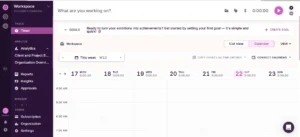
Pricing
- Free Plan: $0/month; unlimited time tracking for up to 5 users.
- Starter Plan: $9/user/month billed annually ($10 billed monthly); includes billable rates and project time estimates.
- Premium Plan: $18/user/month billed annually ($20 billed monthly); adds fixed fee projects, timesheet approvals, and team cost tracking.
- Enterprise Plan: Custom pricing; includes a dedicated success manager, priority support, and custom solutions.
Key Features
- Effortless Time Tracking Software
Toggl provides a time tracking experience with one-click timers, automated tracking, and integrations with over 100 apps. Consultants can log time manually or let Toggl detect idle time and suggest entries. - Billable Rates and Reporting
The Starter Plan introduces billable rates, allowing consultants to assign different rates to projects and clients. Reports provide insights into productivity, helping businesses optimize billable hours. - Team Productivity and Approvals
The Premium Plan includes features like timesheet approvals and team tracking reminders, ensuring accountability across consulting teams. - Project Budgeting and Forecasting
Advanced analytics on the Premium Plan help predict project timelines and labor costs. Consultants can set project budgets and receive alerts when approaching limits.
Pros
- User-Friendly: Simple interface and automated tracking reduce manual entry.
- Billable Rates: Assign custom rates to clients and projects.
- Scalable: Grows with teams, offering approvals and forecasting tools.
- Cross-Platform: Available on web, mobile, and desktop.
Cons
- Free Plan Limitations: Limited to 5 users and lacks billable rates.
- Learning Curve for Advanced Features: Budgeting and forecasting require setup.
Clockify
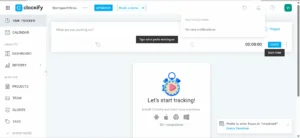
Pricing
- Free Plan: $0/month; unlimited users and unlimited time tracking.
- Basic Plan: $3.99/user/month billed annually ($4.99 billed monthly); includes administrative tools like bulk editing and historical rates.
- Standard Plan: $5.49/user/month billed annually ($6.99 billed monthly); adds invoicing, approval workflows, and QuickBooks integration.
- Pro Plan: $7.99/user/month billed annually ($9.99 billed monthly); includes forecasting, expenses, and GPS tracking.
- Enterprise Plan: $11.99/user/month billed annually ($14.99 billed monthly); offers single sign-on (SSO) and advanced security controls.
Key Features
- Unlimited Free Time Tracking
Unlike Toggl, Clockify offers free unlimited time tracking for all users, making it ideal for consultants looking for a cost-effective solution. - Administrative and Invoicing Tools
The Standard Plan includes invoicing, timesheet approvals, and QuickBooks integration, streamlining billing and financial workflows. - Forecasting and Expense Tracking
The Pro Plan allows consultants to forecast project budgets, track expenses, and monitor labor costs, providing financial clarity. - Security and Compliance for Enterprises
The Enterprise Plan includes advanced security controls like SSO and audit logs, making it a strong option for large consulting firms.
Pros
- Completely Free Plan: Unlimited users and tracking with no cost.
- Comprehensive Invoicing: Built-in billing and accounting tools.
- Project Budgeting: Predict costs and track expenses.
- Enterprise-Grade Security: Compliance features for large teams.
Cons
- Basic Interface: Less polished than Toggl.
- Fewer Automation Features: No automated time tracking like Toggl.
Comparing Toggl vs. Clockify
| Feature | Toggle | Clockify |
| Pricing | Starts at $9/user/month (Starter Plan) | Starts at $3.99/user/month (Basic Plan) |
| Best For | Teams needing automated time tracking | Consultants needing free unlimited tracking |
| Billable Rate | Available in Starter Plan and above | Available in Standard Plan and above |
| Invoicing | Not included | Built-in invoicing tools |
| Forecasting & Budgeting | Premium Plan and above | Pro Plan and above |
| Security & Compliance | Enterprise security available | SSO and audit logs in Enterprise Plan |
Which One is Right for You?
- Choose Toggl if you need a user-friendly interface with automated time tracking, billable rates, and project forecasting. It’s perfect for consultants looking to streamline their workflow with minimal manual input.
- Choose Clockify if you need an affordable, feature-rich time tracking tool with built-in invoicing, budget tracking, and unlimited free users. It’s great for consultants managing expenses and financial workflows.
Both tools offer excellent time-tracking capabilities, but the right choice depends on whether you prioritize automation (Toggl) or budget-friendly features (Clockify).
Invoicing and Expense Management Software
Managing your finances effectively is essential to track income, manage expenses, and ensure cash flow. The right financial management software simplifies invoicing, reporting, and tax preparation.
QuickBooks
Pricing
- Simple Start: $9/month (first 3 months, then $18); includes income tracking, invoicing, and VAT reporting.
- Essentials: $13/month (first 3 months, then $26); adds bill management, time tracking, and multi-currency support.
- Plus: $18.50/month (first 3 months, then $37); includes recurring transactions, inventory tracking, and budget management.
- Advanced: $35/month (first 3 months, then $70); offers automated workflows, custom reporting, and online backup.
Key Features
- Automated Invoicing and Expense Tracking
QuickBooks makes it easy to send unlimited custom invoices, track income, and categorize expenses. Consultants can connect their bank accounts for real-time financial updates, eliminating manual data entry. - Tax and VAT Compliance
With built-in VAT tracking and tax reports, QuickBooks ensures that consultants stay compliant. Automatic tax calculations simplify filing, reducing stress during tax season. - Project Profitability and Budgeting
The Plus Plan and higher tiers allow consultants to track project budgets, profitability, and recurring transactions. These features help maintain financial control and forecast revenue effectively. - Advanced Reporting and Custom Workflows
The Advanced Plan offers custom reporting fields, automated workflows, and role-based access, making it ideal for larger teams that need detailed financial insights.
Pros
- Comprehensive financial tracking: Covers invoicing, expenses, tax reporting, and budgeting.
- Multi-currency support: Ideal for consultants working with international clients.
- Scalable plans: Offers solutions for freelancers, growing teams, and enterprises.
- Automation: Reduces manual work with automated workflows and bank syncing.
Cons
- Higher-tier plans can be expensive: The most advanced features require the Plus or Advanced plans.
- Learning curve for new users: Extensive features may take time to master.
Xero
Pricing
- Starter Plan: $2.90/month for the first 3 months, then $29; includes invoicing, bank reconciliation, and bill tracking.
- Standard Plan: $4.60/month for the first 3 months, then $46; adds bulk transaction reconciliation and cash flow forecasting.
- Premium Plan: $6.90/month for the first 3 months, then $69; supports multiple currencies and advanced financial insights.
Key Features
- Effortless Invoicing and Billing
Xero simplifies financial management with easy-to-use invoicing tools. Consultants can send quotes, manage bills, and track payments, ensuring cash flow. - Bank Reconciliation and Expense Management
Xero connects directly to bank accounts, allowing automatic reconciliation of transactions. This feature ensures accurate bookkeeping with minimal effort. - Multi-Currency Support and Cash Flow Insights
The Premium Plan includes multi-currency support, making it a great option for consultants with international clients. Real-time cash flow tracking helps businesses stay financially aware. - Project Tracking and Analytics
Xero offers project tracking (starting at $7/month add-on) and Analytics Plus for deeper financial insights. Consultants can monitor revenue, expenses, and profitability in one place.
Pros
- User-friendly interface: Intuitive design makes it easy to manage finances.
- Affordable starter pricing: Lower-cost entry plans compared to competitors.
- Real-time financial insights: Helps consultants stay on top of cash flow.
- Multi-currency support: Included in the Premium Plan.
Cons
- Limited features on Starter Plan: Only allows 20 invoices and 5 bill entries.
- Add-ons for key features: Expense claims and project tracking require extra payments.
QuickBooks vs. Xero
| Features | QuickBooks | Xero |
| Pricing | Starts at $9/month (Simple Start) | Starts at $2.90/month (first 3 months) |
| Best For | Consultants needing full financial control | Small businesses wanting an easy interface |
| Invoicing & Payments | Unlimited custom invoices on all plans | Limited to 20 invoices on Starter Plan |
| Bank Reconciliation | Automated syncing with connected banks | Included on all plans |
| Multi-Currency Support | Available on Essentials and above | Available on Premium Plan |
| Project Tracking | Included in plus plan and higher | Available as an add-on |
Which One is Right for You?
- Choose QuickBooks if you need advanced financial tools, automation, and comprehensive reporting. It’s ideal for consultants who want full control over invoicing, budgeting, and expense tracking.
- Choose Xero if you prefer an easy-to-use financial management tool with lower-cost entry plans and strong bank reconciliation features.
Both tools offer excellent financial management capabilities, but the best choice depends on your business size, budget, and accounting needs.
Bonus Section: Advanced Tools for Specialized Consultants
Not every consultant needs automation or data visualization tools, but if you do, they can be very useful.
Productivity and Automation Software
Automating repetitive tasks not only saves time but also ensures workflows and more consistent results. Zapier and Integromat (Make) stand out as top automation tools, enabling consultants to enhance operations, improve productivity, and focus on strategic goals.
Zapier
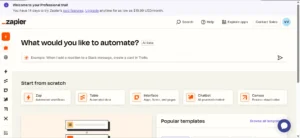
Pricing
- Free Plan: $0/month; 100 tasks per month with unlimited Zaps.
- Professional Plan: $19.99/user/month billed annually; includes multi-step Zaps and access to premium apps.
- Team Plan: $69/user/month billed annually; offers shared workspaces, unlimited users, and team collaboration tools.
- Enterprise Plan: Custom pricing; includes advanced controls, analytics, and a dedicated account manager.
Key Features
- Multi-Step Automation
Zapier’s multi-step Zaps allow consultants to connect multiple apps and automate complex workflows. For instance, a single trigger (like receiving a lead) can update your CRM, send a welcome email, and assign a task in your project management tool—saving hours of manual work. - Extensive App Integrations
Zapier connects with over 2,000 apps, including popular tools like Slack, Trello, HubSpot, and Google Workspace. This wide compatibility ensures all your tools work together, reducing operational silos. - AI-Powered Automation
Zapier’s AI tools simplify automation setup, offering features like automated Zap building, error troubleshooting, and code generation. These enhancements make it easy for consultants to create efficient workflows without technical expertise. - Team Collaboration
For teams, Zapier’s shared workspaces and app connections ensure collaboration. Team members can share workflows, assign permissions, and maintain centralized control over automation processes. - Scalability
From individuals to enterprises, Zapier caters to all business sizes. Enterprise plans include advanced admin controls, analytics, and security features like SAML SSO, making it ideal for scaling organizations.
Pros
- Saves Time: Automates repetitive tasks to free up time for strategic work.
- Wide Compatibility: Connects with thousands of apps for workflows.
- AI-Driven Features: Speeds up setup and improves automation efficiency.
- Team-Friendly: Offers collaboration tools for shared workflow management.
- Scalable Plans: Flexible pricing for both startups and large businesses.
Cons
- Task Limits: Free plan allows only 100 tasks per month, limiting heavy usage.
- Cost for Advanced Features: Higher-tier plans can strain small business budgets.
- Complexity for Beginners: Advanced Zaps may require time to master.
Integromat (Make)

Pricing
- Free Plan: $0/month; includes 1,000 operations per month and core tools.
- Core Plan: $9/month billed annually; offers unlimited scenarios and API access.
- Pro Plan: $16/month billed annually; adds advanced features like custom variables.
- Teams Plan: $29/month billed annually; includes multiple team management and high-priority executions.
- Enterprise Plan: Custom pricing; offers enhanced security, compliance, and advanced capabilities.
Key Features
- Visual Workflow Builder
Integromat’s drag-and-drop interface makes creating complex workflows intuitive and easy to understand. Users can visually map out connections between apps, ideal for those new to automation. - Advanced Customization
Integromat supports advanced functions like dynamic connections, custom scenarios, and large data handling. These features enable consultants to build tailored workflows that meet specific business needs. - Affordable Entry Point
Starting at $9/month, Integromat is one of the most budget-friendly automation tools available, offering features without breaking the bank. - Enhanced Security for Enterprises
Enterprise plans include features like single sign-on (SSO), compliance support, and advanced audit logs, making Integromat a strong choice for larger organizations.
Pros
- Visual Interface: Simplifies automation design with drag-and-drop workflows.
- Cost-Effective: Budget-friendly plans starting at $9/month.
- Advanced Capabilities: Custom scenarios and dynamic connections for tailored solutions.
- Scalability: Enterprise-grade security and compliance features for growing organizations.
Cons
- Smaller App Library: Fewer integrations compared to Zapier.
- Complex Advanced Features: Some advanced customizations may require technical expertise.
Zapier vs. Integromat (Make)
| Features | Zapier | Integromat (Make) |
| Pricing | Starts at $19.99/month (Professional Plan) | Starts at $9/month (Core Plan) |
| Best For | Consultants needing broad app integrations | Teams preferring a visual workflow builder |
| App Library | 2,000+ apps | Similar library |
| Workflow Design | Multi-step automation with advanced logic | Intuitive drag and drop design |
| Team Collaboration | Shared workspace for teams | Advanced team features on higher plans |
| AI Features | AI-powered Zap creation and trouble shooting | Limited AI capabilities |
Which One is Right for You?
- Choose Zapier if you need broad app integrations, AI-driven automation, and team features for managing complex workflows.
- Choose Integromat (Make) if you prefer a more visual approach to automation, need advanced customization, or are working with a tighter budget.
Key Takeaways and Actions
The right software tools help consultants work smarter, save time, and improve client relationships. Here’s how:
- Boost Productivity: Automate tasks with Zapier or Integromat (Make) to reduce manual work. Track billable hours with Toggl or Clockify to ensure accurate invoicing and better time management.
- Stay Organized: Manage projects with Asana or Trello to keep tasks on track. Capture and organize ideas with Notion or Evernote for quick access when needed.
- Improve Client Communication: Use Slack or Microsoft Teams for messaging and collaboration. Keep client interactions organized with HubSpot CRM or Zoho CRM to track leads and automate follow-ups.
- Secure Files & Manage Finances: Store and share documents with Google Drive or Dropbox for easy access. Handle invoicing and expense tracking with QuickBooks or Xero to keep finances in order.
Investing in these tools will streamline your work, enhance efficiency, and help you scale your consulting business with ease. Start small and expand as needed!




